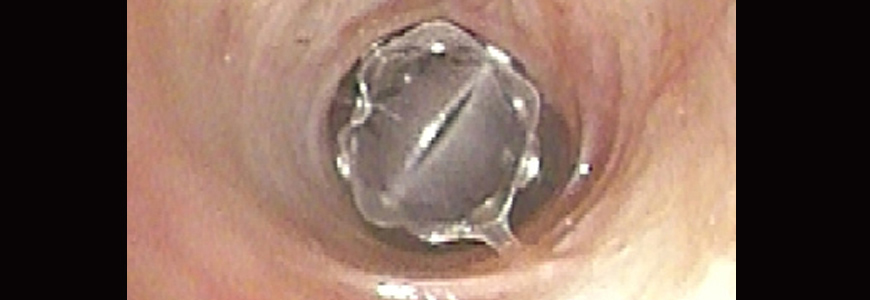Duke interventional pulmonologists have introduced a minimally invasive lung volume reduction procedure using a newly FDA-approved endobronchial valve (EBV) to expand treatment options for patients with emphysema.
Implantation of the valve will supplement more traditional treatments such as surgical lung volume reduction and lung transplantation, says Momen M. Wahidi, MD, MBA, director of Duke’s Interventional Pulmonology Program. Duke is one of the first centers in the Southeastern U.S. to offer the therapy; the Zephyr EBV was developed by Pulmonx (Redwood City, CA).
“Surgical lung volume reduction as a treatment for emphysema became an option a decade ago, but some patients are too sick for the surgery and may experience complications due to procedural risks,” Wahidi says. “The research to develop an alternative has led us to this valve technology.”
A standard bronchoscope and flexible delivery catheter are used to position the EBV in the most destroyed lobe of the lung, Wahidi says. The self-sealing, one-way valve allows trapped air and fluid to escape but closes off the lobe to further ventilation. The valve reduces air volume within the diseased lobe, enabling healthier lobes to expand and function more efficiently.
“By blocking the bronchial tubes leading to the parts of the lung that have been most destroyed, we will give the healthier tissues in the lung more space to perform the breathing function efficiently,” Wahidi says. “The diaphragm returns to its natural shape, improving breathing mechanics.”
EBVs are not suitable for every emphysema patient, Wahidi cautions, because some patients may have a network of collateral ventilation (side channels) preventing target lobe collapse. The presence of collateral ventilation is usually assessed via a chest CT scan and air flow measurement during the procedure.
Wahidi cited three immediate benefits for patients with emphysema:
- Improves lung function, exercise tolerance, and quality of life in symptomatic patients.
- Offers an alternative to lung volume reduction surgery for patients who are not surgical candidates.
- Expands treatment options when patients are assessed for EBV therapy.
Patients undergo a comprehensive evaluation and may be recommended for other treatment therapies if they are not candidates for EBV. Options include pulmonary rehabilitation, lung transplantation, surgical lung volume reduction, and participation in research trials of other novel bronchoscopic treatments.
Duke interventional pulmonologists offering this procedure include Wahidi, Coral X. Giovacchini, MD, Kamran Mahmood, MD, MPH, and Scott L. Shofer, MD, PhD.
